

Seat of three empires. Crossroads of the crusades. Meeting place of Europe and Asia. Istanbul has played a major role on the stage of world history. Constantine, emperor of Rome, moved the capital of the empire to Istanbul around 3 AD, and called the city Constantinople. After the fall of the Roman state and the separation of the Christian church, the growing city on the Bosporus became Byzantium, home to the eastern orthodox religion. During the Ottoman reign, lands were conquered south to central Africa, east to Jerusalem, west to Spain, and north through the Balkans. The enormity of wealth and power assembled during the empire's dominance can only be appreciated by visiting this magical place.
We found a charming hotel in the old city, located next to the palace. Cool, rainy weather kept us indoors for the first couple of days, and we enjoyed the down time resting and relaxing. We started our tour with a visit to the Cistern, Istanbul's underground water supply, safely hidden from conquering enemies. Classical music played in the background to soften the dark, wet, cave-like atmosphere. (We even danced a short waltz!) Columns from Greek temple ruins were brought to Istanbul for its construction. The left picture shows the Column of Tears. Two shorter columns were perched on giant sculptures of the Goddess Medusa (picture below right). And why does the goddess stand on her head? Each guide offers a different theory.
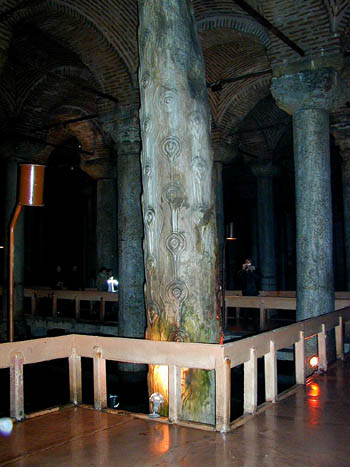
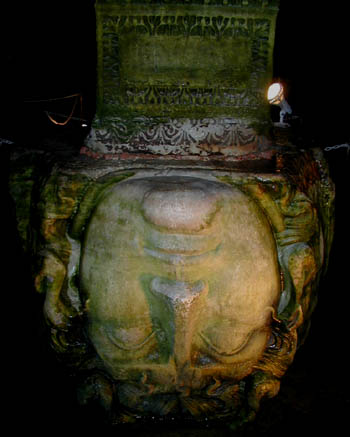
The Blue Mosque (top picture) is one of Istanbul's most famous landmarks. The inside is decorated, as are many mosque interiors around Istanbul, with famous Turkish hand painted tiles in red, blue and green. A huge dome and numerous half domes, all filled with stain glass windows, add to the splendor of this beautiful structure. Unfortunately, the countless layers of precious, old, handwoven carpets have been moved to a musem and replaced with regular carpeting. Next door, ruins from an old roman palace were discovered and a series of mosaic floor scenes have been preserved. The museum displays some floors in their original locations, other fragments hang on the walls (pictures below). One square foot includes approximately 900 tiny glass, ceramic or semiprecious stone tiles.
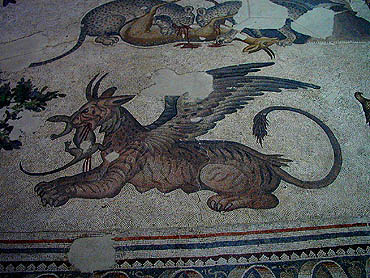

The charming waiter, who served us a tasty Turkish lunch, spoke good English and enjoyed our company. Before long, the restaurant's owner Kazim joined in our discussions. Talk of Turkey, America, and our trip somehow led to relationships and marriage. Kazim, a 32-year-old bachelor, expressed his great difficulty in finding a companion. He has tried various methods to meet the right woman, including personal ads, internet chat rooms, and dating services with no luck. We decided to give him a spot on our web site: Kazim and his establishment, the Hotel Arasta.
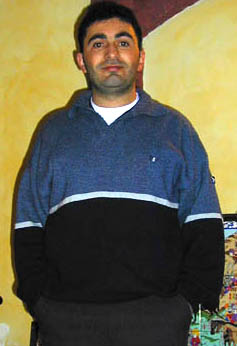

Interested single women, or anyone looking for a nice place to stay in Istanbul, can e-mail Kazim at: Kazimaltan@yahoo.com.
The world-famous bazaar (pictured below) is located in an endless maze of colorful hallways filled with every product the shopper may desire. A series of old buildings with beautifully decorated arched passageways are linked together to form this huge shopping complex. Small stores line the narrow streets, selling handcrafted carpets, gold jewelry, leather goods, spices, antiques, smoking supplies, board games, clothing and many other items. Persistent salesmen stand in front of the shops, praise their goods for sale and invite the passersby to come inside. The shopkeeper will feel insulted if you don't participate in a round of negotiating. Walking from one aisle into the next, you soon lose your bearings and must exit to reorient yourself. We visited the bustling bazaar three times to buy a handmade backgammon set, chess pieces and spices. After each negotiation, I was complimented on my business skills. It was obvious I could have paid less, but the deals were very acceptable.
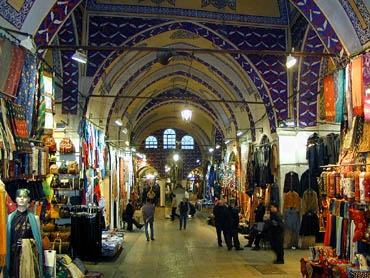
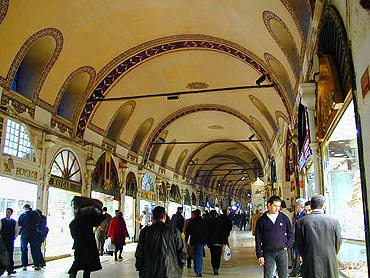
Our tour of the Topkapi Palace included sunshine and blue skies. The complex is designed around a series of open courtyards, and used to be home to about 2,000 people: the Sultan, his extensive harem and family, and their staff. The first courtyard (below, top left) was beautifully landscaped, and criss-crossed with walkways leading to colonnaded buildings along the perimeter. In one hall, we viewed a collection of china, vases and serving pieces of the finest hand painted ceramics, gold, silver and precious stones. The treasury fills four rooms with priceless jewelry (bottom right), weapons, clothing, and furnishings (such as the throne bottom left).
A collection of holy relics included the staff of Moses; a footprint casting, koran book, and hair from the prophet Mohammed; and other ancient religious items. The harem, living quarters of the royal family, is a labyrinth of hallways leading to numerous lavishly decorated rooms where only the sultan, his countless women and eunuchs were able to enter. Here the wives and mistresses played out their intrigues and tried to win the sultan's attention. A variety of other buildings, including a library, an octagonal sitting room, an audience hall, and a small theater, complimented by gardens, terraces, pools and fountains, completed the sultan's playground. Like inside the mosques, the famous hand painted tiles (below, top right) adorned interior and exterior walls.
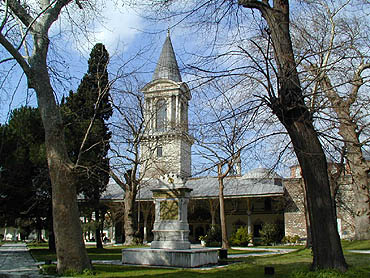


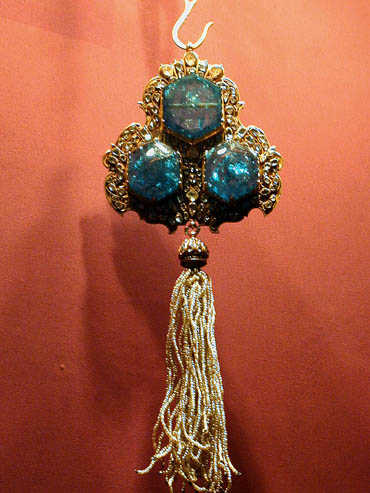
We next visited Hagia Sophia, the largest mosque in Europe. It was built as a church in the fifth century and later converted to a mosque. The huge central dome, two half domes, and tall stained glass windows tower over the cavernous interior. As a result of poor upkeep and many earthquakes, the huge structure is beginning to show major areas of complete disrepair, and is now functioning only as a museum. A number of amazing original mosaics have survived in spectacular condition (pictured below).
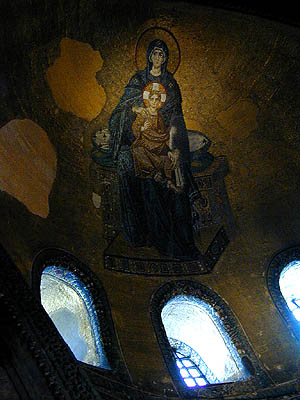
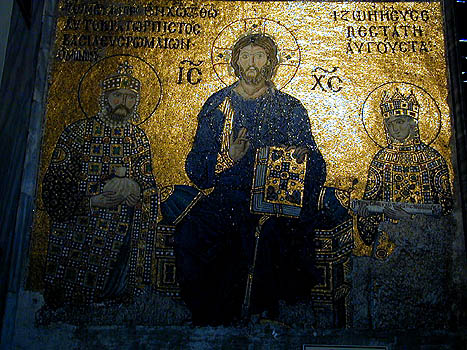
Compelled by the minaret-filled skyline of Istanbul, we spent a day visiting some of the other famous mosques. Each time we entered, we had to remove our shoes, and Elke had to cover her head. Although I can't remember their names, each one had something special to offer (like the ancient cemetery, bottom row right), and rewarded us for our diligence. On our tour we passed by the remains of a roman aqueduct. Some of the pictures from this excursion follow.
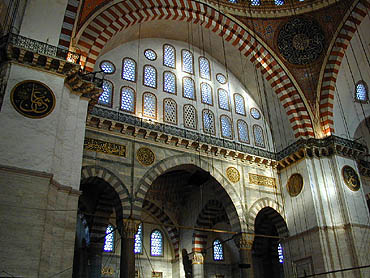
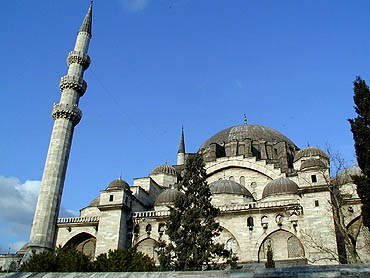


After a breezy boat ride on the Bosporus and a visit to another famous mosque along the waterway (photo below left, in the background the gigantic bridge connecting the European to the Asian side of Istanbul), we stopped for refreshments in a cute cafe (below right) The sun was warm and allowed us to sit outside, and take in the views across the Bosporus into Asia. A short walk from the mosque pictured below stands one of the last royal palaces built in Istanbul. We took a guided tour through the most lavishly decorated rooms, finished in the late 19th century. The amount of gold, fine china, large silk carpets and precious artifacts shouted money, power and extravagance.
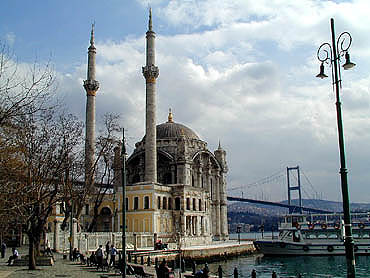

We spent our last morning inside the Archaeological Museum. The highlight of the currently open exhibitions was a series of giant sarcophagi discovered in an ancient tomb near Istanbul. Intricate scenes and pictures are carved into the stone faces on all sides (pictures below). Other rooms showcased Greek and Roman sculptures, sarcophagi and other artifacts. Unfortunately, a large section of the museum was closed due to recent earthquake damage.
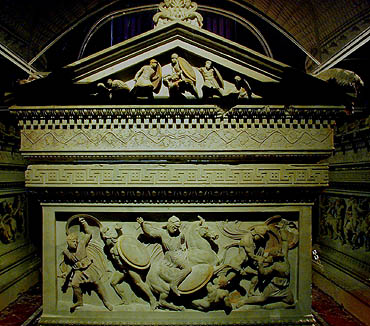

Istanbul certainly knows how to entertain its visitors. We had breathed the city's exotic atmosphere; savored the aromatic, hearty Turkish foods; gazed into the airy domed interiors of many colorful mosques; imagined the conspiracies controlling the harem; joined the local life in bustling streets, bazaars and tiny alleys. A shopping extravaganza. A cultural education. A feast for the senses!